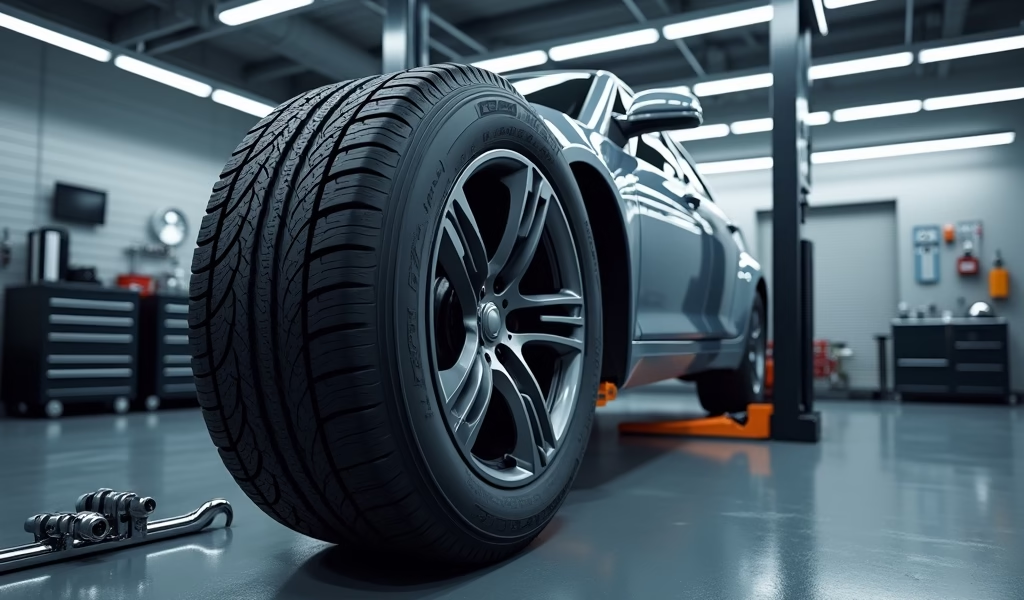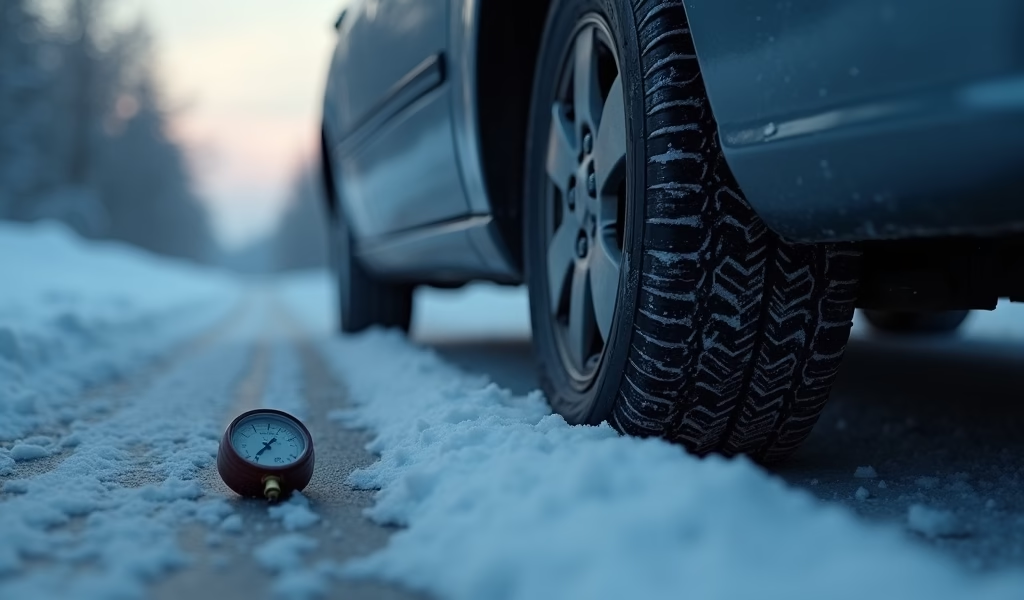Overview
This article provides five essential snow tire maintenance practices from a 20-year mechanic: regular pressure checks, proper off-season storage, routine tread inspection, consistent rotation schedules, and professional inspections. Proper maintenance extends tire life by up to 20%, ensures optimal winter performance, and significantly enhances safety during hazardous driving conditions.
Table of Contents
- Introduction
- Regular Pressure Checks: Your First Line of Defense
- Proper Storage: Treating Your Snow Tires Right in the Off-Season
- Routine Tread Inspection: Reading What Your Tires Are Telling You
- Rotation Schedule: The Secret to Even Wear and Longer Life
- Professional Inspection: When Expert Eyes Matter
- Conclusion
- Frequently Asked Questions
Introduction
After 20 years working as a certified mechanic in the snowy Northeast, I’ve seen what happens when folks neglect their snow tires – and it isn’t pretty. Your vehicle’s connection to those slippery winter roads comes down to just four hand-sized contact patches. That’s it. Those specialized rubber compounds and aggressive tread patterns are engineering marvels designed specifically for winter conditions, but they need proper care to do their job right.
I’ve put together these five proven maintenance tips based on what I’ve seen work for thousands of customers who drive safely through even the harshest winters. These aren’t just suggestions – they’re essential practices that could save you money and potentially prevent accidents when those roads turn treacherous.
If you’ve invested in quality snow tires for your vehicle, you’ve already made a smart decision. Now let’s make sure you get the most performance, safety, and value from them.
Regular Pressure Checks: Your First Line of Defense
Here’s something most folks don’t realize: for every 10-degree drop in temperature, your tire pressure decreases by roughly 1 PSI. During winter months, this silent deflation happens constantly, often without you noticing. That’s why checking pressure becomes your first and most important maintenance task.
I recommend checking your snow tire pressure weekly during winter, especially after significant temperature drops. Finding your vehicle’s correct PSI couldn’t be simpler – look for the manufacturer’s recommendation on the sticker inside your driver’s door jamb or in your owner’s manual. And here’s a common mistake to avoid: the number printed on the tire sidewall is the maximum pressure, not the recommended one.
Properly inflated snow tires deliver benefits you’ll feel immediately:
- Significantly better traction on snow and ice
- Improved fuel efficiency (saving money during those holiday road trips)
- Even tread wear for extended tire life
- Enhanced handling and braking response in critical situations
I’ve had customers ask if they should reduce pressure for better snow traction. The answer is a firm no. Underinflation actually reduces the effectiveness of the specialized siping and tread patterns that make winter tires perform in snow. Stick with the manufacturer’s recommendation – they’ve tested these tires extensively in winter conditions.
For accurate readings, check pressure when tires are cold (before driving or at least three hours after). A quality digital gauge costs under $15 and fits in your glove box – consider it cheap insurance for your winter driving safety.

Proper Storage: Treating Your Snow Tires Right in the Off-Season
When spring arrives, how you store your snow tires determines whether they’ll be ready for action next winter. I’ve seen too many perfectly good snow tires ruined by improper storage, and it breaks my heart knowing it’s completely preventable.
Before storing, give those tires a thorough cleaning. Road salt and winter grime contain corrosive compounds that continue damaging rubber even in storage. Wash with mild soap and water, then dry completely. A tire protectant specifically formulated for rubber (not your regular “tire shine”) can help prevent UV damage and cracking during storage.
The ideal storage environment for snow tires resembles a cool, dry cellar rather than a hot garage or outdoor shed. Aim for:
- Temperatures between 50-75°F (10-24°C)
- Low humidity levels
- Protection from direct sunlight
- Distance from ozone-producing equipment (electric motors, furnaces, etc.)
If you’re storing tires still mounted on rims, I recommend stacking them horizontally. For unmounted tires, standing them vertically is better, rotating their position monthly if possible. Tire bags provide excellent protection, but even clean garbage bags can work in a pinch – just remove as much air as possible before sealing to prevent moisture buildup.
Why go through all this trouble? Because proper storage can add 1-2 additional seasons to your tire lifespan. When you consider that a quality set of snow tires can cost $600-1,200, that extra season represents significant savings.
A customer once told me he thought his tires looked “fine” after being stored in his hot attic. They looked okay to the untrained eye, but I spotted the subtle cracking and compound degradation immediately. Unfortunately, these compromised tires failed him during the first heavy snowfall – a costly lesson in proper storage.
Routine Tread Inspection: Reading What Your Tires Are Telling You
Your snow tires constantly communicate with you, telling stories about road conditions, your driving habits, and their remaining useful life. Learning to read these signs doesn’t require special training – just knowing what to look for.
Measuring tread depth is essential for snow tires because their winter performance drops dramatically as tread wears down. While the legal minimum tread depth is 2/32 inch, for adequate snow performance, you need at least 6/32 inch. The difference between these measurements can mean stopping in time or sliding through an intersection.
The classic penny test works perfectly for checking: insert a penny with Lincoln’s head upside down into your tire tread. If you can see the top of Lincoln’s head, your tread is below 2/32 inch and the tire needs immediate replacement. For snow-specific performance, use a quarter instead – if you can see the top of Washington’s head, your tread is below 4/32 inch and winter performance is already compromised.
Beyond depth, pay attention to these wear patterns that signal problems:
- Center wear: Usually indicates overinflation
- Edge wear on both sides: Typically signals underinflation
- Wear on just one edge: Often points to alignment issues
- Scalloping or cupping: May indicate suspension problems
I had a customer insist her snow tires were fine despite showing significantly more wear on the outer edges. After convincing her to check her tire pressure, she discovered she’d been driving 8 PSI below recommendation all winter. The proper inflation immediately improved her vehicle’s stability and handling in snow. These visual clues are your tires literally showing you what they need.
Most snow tires come with “wear bars” – raised sections in the tread grooves that become flush with surrounding tread when the tire reaches minimum safe depth. When these bars become visible across multiple grooves, consider it your tire’s way of waving a white flag.
According to NHTSA research on tire safety, proper tread depth is critical for preventing hydroplaning on wet, slushy winter roads. Their studies show accident rates increase significantly once tread depth falls below 4/32 inch in winter conditions.
Rotation Schedule: The Secret to Even Wear and Longer Life
Tire rotation is one of those maintenance items people tend to skip, but it’s particularly crucial for snow tires. Due to the softer rubber compounds used in winter tires, uneven wear happens faster than with all-seasons, making regular rotation even more important.
I recommend rotating your snow tires every 3,000-5,000 miles during the winter season. If you typically install them in November and remove them in April, that likely means one mid-season rotation for most drivers. This simple service can extend tire life by up to 20% – a significant return on a 30-minute investment.
The rotation pattern depends on your vehicle’s drive type:
- For front-wheel drive: Move front tires to the rear in straight lines, and cross rear tires to the front
- For rear-wheel drive: Move rear tires to the front in straight lines, and cross front tires to the rear
- For all-wheel drive: Cross tires in an X pattern (front-left to rear-right and front-right to rear-left)
I always tell my customers to think of rotation as giving each tire a turn at doing the hardest job. In front-wheel-drive vehicles, front tires do most of the work (accelerating, steering, and most braking). Without rotation, they’ll wear out long before the rear tires, forcing you to replace the whole set prematurely.
Consider combining rotation with other maintenance services like oil changes to save time. Many shops offer free or discounted rotations with other services. Just be sure they’re following the correct pattern for your drive type.
The experts at Tire Rack confirm that proper rotation significantly extends tire life, particularly for directional winter tires that require specific rotation patterns. Their testing shows up to 25% more usable life from consistently rotated tires.

Professional Inspection: When Expert Eyes Matter
While the maintenance tips I’ve shared are things you can absolutely do yourself, there’s still value in having professional eyes check your snow tires occasionally. Mechanics have seen thousands of tires and can spot subtle issues that might escape notice during home inspections.
I recommend scheduling professional inspections at two key times:
- Before winter installation (to ensure tires are safe and ready for service)
- During spring removal (to identify any issues before storage)
Professional technicians evaluate aspects that home inspections typically miss:
- Internal belt damage not visible from the outside
- Subtle alignment issues affecting wear patterns
- Age-related rubber compound deterioration
- Proper mounting and balancing needs
One customer insisted her snow tires were perfectly fine despite being over 10 years old. They had plenty of tread, but when I showed her the tiny cracks forming in the rubber compound (a condition called “dry rot”), she understood why these tires were no longer safe. Age affects rubber even when tread depth remains adequate.
Most tire shops offer free inspections, especially if you purchased your tires from them. Take advantage of this service – it’s like having a doctor give your tires a physical before the demanding winter season.
When selecting a tire professional, look beyond price. Ask about their experience with winter tires specifically, as mounting and balancing them often requires different techniques than all-seasons, particularly with the special wheels many people use for their winter sets.
Conclusion
After two decades helping customers navigate winter driving safely, I’ve seen firsthand how these five snow tire maintenance practices make a real difference. Proper pressure maintenance, careful off-season storage, regular tread inspections, consistent rotation, and occasional professional assessments aren’t just mechanical recommendations – they’re investments in your safety and your wallet.
Well-maintained snow tires provide predictable performance exactly when you need it most – during that unexpected snowstorm or on that icy morning commute. They stop shorter, corner more confidently, and help you avoid the accidents that seem to multiply during winter weather.
Remember, your vehicle’s tires represent the only points of contact between two tons of metal and the winter road beneath. Taking care of these crucial components isn’t just smart maintenance—it’s an essential safety practice that protects you and everyone sharing the road with you.
If you haven’t already, I encourage you to develop these snow tire maintenance habits before the next winter season arrives. The peace of mind that comes with proper preparation is worth every minute spent. Stay safe out there!
Frequently Asked Questions
How long do snow tires typically last?
With proper maintenance, quality snow tires typically last 3-4 winter seasons or approximately 30,000 miles of winter driving. Actual lifespan depends on driving conditions, maintenance practices, and proper storage during off-seasons.
Can I use snow tires year-round?
No, snow tires should not be used year-round as their softer rubber compounds wear rapidly in warmer temperatures. Summer heat causes premature wear and reduces both tire lifespan and performance.
Is it OK to use two snow tires instead of four?
No, installing only two snow tires creates dangerous handling imbalances between the front and rear of your vehicle. Always install a complete set of four matching winter tires for predictable handling and safety.
How do I know if my snow tires need to be replaced?
Replace snow tires when tread depth reaches 6/32 inch (winter performance is already compromised) or when sidewalls show cracking, bulging, or other damage. Age-related deterioration typically requires replacement after 6-7 years regardless of tread remaining.
Do snow tires affect fuel economy?
Yes, snow tires typically reduce fuel economy by 1-3 mpg due to their more aggressive tread patterns creating additional rolling resistance. However, properly inflated snow tires minimize this effect while maintaining safety benefits.

